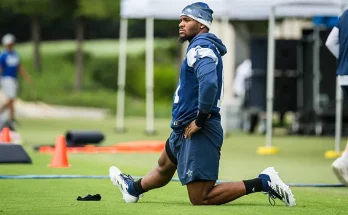The numbers speak for themselves. Four hundred assists in just 48 games. It’s not just a statistic—it’s a statement. A thunderous declaration that we’re witnessing a generational playmaker rewriting what it means to distribute the ball in modern basketball. The pace is historic. The vision is surgical. The impact? Unquantifiable. In a league packed with explosive scorers and defensive juggernauts, this player is standing out in a way that forces the basketball world to pay attention.
From the very first game of the season, there was a sense that something special was brewing. The passes were crisp, the reads were instantaneous, and the chemistry with teammates seemed almost telepathic. Fans who were lucky enough to be in the arena early on noticed how each possession was orchestrated like a symphony, with our protagonist serving as the maestro. It wasn’t long before the league started to buzz. Analysts took notice. Opposing coaches adjusted game plans. Defensive specialists were assigned. But none of it mattered. The assists kept coming.
Let’s put this into perspective. Averaging over 8 assists per game is considered elite in today’s game. But maintaining that level over nearly 50 games, without a drop-off, while keeping turnovers low and efficiency high? That’s unheard of. That’s not just about skill—it’s about consistency, intelligence, leadership, and perhaps most importantly, trust. Trust from teammates to be in the right place. Trust from the coaching staff to run the offense through your hands. Trust in your own instincts to make the right play, over and over again.
What makes this assist spree even more remarkable is how it elevates everyone else on the floor. Basketball, at its core, is a team game, and few statistics reflect that truth like assists. An assist isn’t just a pass—it’s an opportunity. It’s timing. It’s vision. It’s generosity. And to rack up 400 of them in 48 games is to say that this player has created 400 moments of scoring for teammates. That’s 400 plays where a defense was dissected, a cutter was found, a shooter was hit in rhythm, or a big man got an easy bucket down low.
Every generation has had their great facilitators. The Magic Johnsons, the John Stocktons, the Steve Nashes. And now, this player is throwing their name into that rarified conversation. But what’s perhaps most thrilling is how this milestone isn’t a celebration of past greatness—it’s a glimpse into what’s coming. Because if this is what they’re doing in just 48 games, imagine the records that could fall by the end of the season. Imagine what a full career could look like at this pace.
Digging deeper, the 400-assist milestone reveals more than just incredible passing. It speaks to durability. To be available and effective game in and game out is no small feat. It speaks to endurance, both physical and mental. The grind of a long season takes its toll on the body and the mind, yet this player has managed to stay sharp, composed, and dominant. There’s a rhythm to their game that’s almost hypnotic—never rushed, never forced, just in control.
There’s also a swagger that comes with this kind of excellence. Not arrogance, but confidence. The kind that comes from knowing you can control the tempo of a game with a flick of your wrist. That you can see passing lanes before they open. That you can create offense even when the play breaks down. Fans feed off it. Teammates thrive on it. The entire energy of the team shifts when the floor general is in command.
Media outlets have started running out of superlatives. “Unstoppable.” “Masterful.” “Otherworldly.” The highlight reels circulate on social media within minutes of each game’s end, often before the final buzzer sounds. The behind-the-back dimes. The no-look lasers. The impossible-thread passes through traffic. They’re not just feats of athleticism—they’re works of art. Basketball purists watch in awe, while kids on playgrounds try to imitate the magic.
Opponents, meanwhile, are learning that there’s no easy way to defend against someone who sees the court like this. Throw a double team? They’ll find the open man. Collapse the paint? They’ll hit the corner shooter. Go under the screen? That’s an invitation for a skip pass that leads to three points. The adaptability is off the charts. And that’s what makes it so dangerous. You can’t game plan against instinct. You can’t coach against genius.
Coaches around the league have been vocal in their praise. “He’s the best passer we’ve faced all season,” one head coach admitted after a recent loss. “There’s nothing you can do to speed him up or slow him down. He plays at his own pace, and he gets everyone involved. It’s a nightmare for defenses.” Another added, “The ball just moves better when he’s on the floor. It’s contagious. You can see it. The whole team believes in what they’re doing.”
And it’s not just the offensive end. This level of playmaking puts pressure on opponents psychologically. When you know the ball can be anywhere at any moment, you’re hesitant. You hesitate on switches, on help defense, on closeouts. That split second is all the window this player needs to exploit the defense. That’s the power of passing at this level. It tilts the floor. It stretches the defense beyond its limits. It breaks the game.
This run also brings attention to the importance of unselfish basketball in an era often defined by isolation play and individual scoring feats. While scoring titles and highlight dunks tend to dominate headlines, this player is proving that pure, selfless playmaking is still the engine of elite basketball. Teammates are eating. The offense is flowing. Wins are piling up. And at the center of it all is someone who seems to care more about the assist column than the point total.
Yet, for all the awe-inspiring numbers, there’s something deeply human about this achievement. The hours of practice. The film sessions. The time spent building chemistry with teammates. The willingness to be held accountable. The desire to lift others. It’s not glamorous work—but it’s the work of greatness. And it’s what separates this player from the rest.
As the season barrels forward, the spotlight will only grow brighter. Expectations will mount. Defenses will tighten. And the question will loom: Can the pace be maintained? If history is any guide, the answer is yes. Because this isn’t a fluke or a hot streak. It’s not a product of a weak schedule or inflated usage. It’s the result of elite basketball IQ, tireless preparation, and a hunger to dominate through teamwork.
Fans are already marking their calendars. Each game now becomes a must-watch event. How many assists tonight? Who will be the beneficiary this time? What pass will make us all shake our heads in disbelief? The excitement isn’t just about winning—it’s about watching someone redefine how the game can be played. It’s about seeing a master at work.
When the season ends and the awards are handed out, there will be debates. MVP conversations. All-NBA honors. But long after the trophies are handed out and the banners are raised, this 400-assist milestone will stand as a monument to the beauty of basketball done right. To the joy of sharing the ball. To the brilliance of making others better. It’s more than just a number—it’s a revolution in motion.
In a world chasing flash, this player has made substance stylish again. In a league driven by stars, they’ve chosen to illuminate others. And in a sport defined by moments, they’re creating hundreds of them—one pass at a time.
So here we are. Forty-eight games in. Four hundred assists on the ledger. A season not just of stats, but of statements. And the message is loud and clear: greatness isn’t always about scoring the most points—it’s about making the people around you shine. And in that regard, this player isn’t just great. They’re transcendent.



